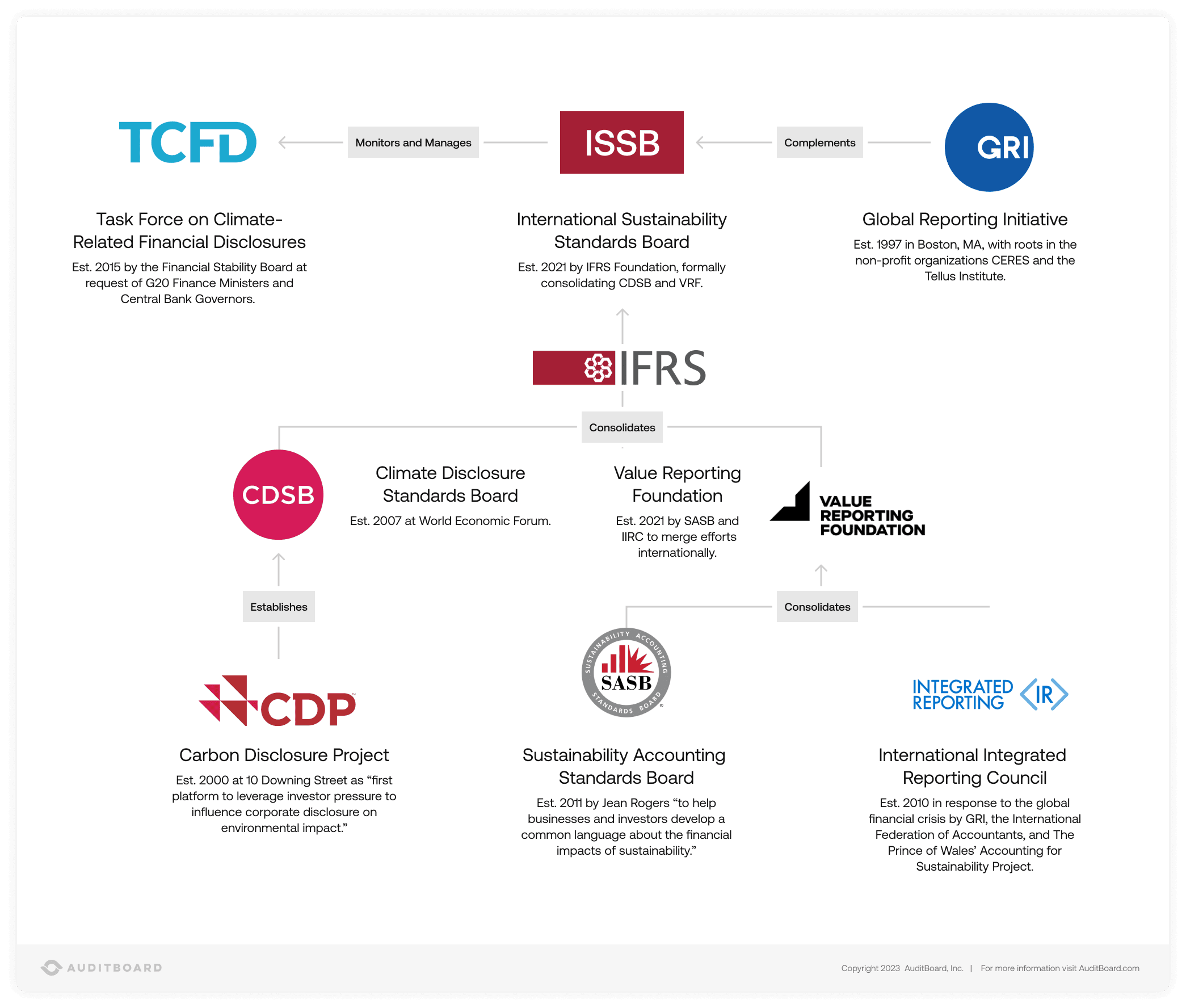
September 22, 2022 • 8 min read
Beyond ESG: ISSB Consolidation Heralds a New Era in Corporate Reporting and Assurance

John A. Wheeler
Over the past two decades, the environmental, social, and governance (ESG) disclosure landscape has become a hard-to-decode alphabet soup. The Global Reporting Initiative (GRI), Sustainability Accounting Standards Board (SASB), Task Force on Climate-Related Disclosures (TCFD), Climate Disclosure Standards Board (CDSB), Carbon Disclosure Project (CDP), International Integrated Reporting Council (IRRC), Value Reporting Foundation (VRF), and others have created an array of overlapping frameworks.
Companies seeking to align corporate reporting with accepted ESG standards have chosen from one or more of these frameworks. But as an ever-wider pool of stakeholders sought to use ESG reporting in their decision-making, the need for consistency, transparency, and comparability became clear. The past two years have been pivotal for ESG consolidation and alignment, culminating in the IFRS Foundation’s 2021 formation of the International Sustainability Standards Board (ISSB). By creating the ISSB, the IFRS Foundation is working to harmonize an array of existing ESG reporting frameworks into a comprehensive and authoritative global baseline for sustainability disclosure requirements.
The IFRS Foundation has also consolidated several standard setters, including the Climate Disclosures Standard Board (CSDB) and the Value Reporting Foundation (VRF) with an eye toward integrating financial and non-financial metrics in a single corporate reporting framework. The inclusion of non-financial metrics in corporate reports is supported by the European Union’s (EU) current Non-Financial Reporting Directive (NFRD) and soon-to-be-established Corporate Sustainability Reporting Directive (CSRD). When the CSRD is finalized, the EU estimates that 49,000 companies will be required to share non-financial metrics related to environmental and social risks. By incorporating non-financial metrics in corporate reporting, the IFRS Foundation standards could ultimately become the new baseline for businesses worldwide.
In March 2022, ISSB issued its exposure drafts (the “General Requirements Standard” and the “Climate Standard”) and the SEC issued its proposal for “The Enhancement and Standardization of Climate-Related Disclosures for Investors.” ISSB is expected to finalize standards sometime between their September board meeting and year-end. These new standards and EU regulations will impact not only companies headquartered in the EU, but also those with significant operations in the EU. So, make no mistake, integrated ESG reporting is on its way. Make sure you understand the consolidation that has occurred, what it means for global ESG standard-setting activity — and how it may impact your business.
A Recipe for Alphabet Soup
ESG’s alphabet soup has been brewing for years. Since 1997, ESG organizations have formed and merged in response to world events, market demands, and the urging of global leaders. The graphic below (modeled on Kirkland & Ellis’s) offers context on the ISSB consolidation, including key dates.

Recent ESG Consolidation and Collaboration
GRI, SASB, IIRC, CDP, and CDSB announced a commitment to aligning reporting frameworks and developing a “comprehensive corporate reporting system” in 2020. In June 2021, US-based SASB and London-based IIRC merged to form VRF with the goal of helping companies use integrated reporting to drive a more holistic approach to enterprise value creation. Only six months later, during the UN Climate Change Conference in Glasgow (COP26), the IFRS Foundation announced the formation of the ISSB and the intention to consolidate CDSB and VRF into ISSB in 2022. That consolidation is now complete.
As the graphic above shows, sustainability standards pioneer GRI will still exist on its own. But GRI and ISSB are collaborating to harmonize efforts, suggesting that the two standards “can be viewed as two interconnected reporting pillars that address distinct perspectives, which can together form a comprehensive corporate reporting regime for the disclosure of sustainability information.” Similarly, the more climate-focused TCFD will continue to operate independently. TCFD’s recommendations, which gained the G20’s endorsement in 2021, are strongly influencing ISSB’s approach.
The pledged harmonization seems to be happening. ISSB says it is building the standards upon the four pillars of TCFD’s sector- and jurisdiction-agnostic framework, incorporating industry-based requirements based on SASB Standards, and collaborating with GRI to align terminology, guidance, and standards where possible. Whereas TCFD focuses primarily on making investor-focused recommendations for climate disclosures, SASB and GRI have a broader sustainability focus and are designed to meet the needs of a broader group of stakeholders. ISSB has also organized a working group of global financial regulators (including the SEC) to examine the compatibility of standard-setting activities across a broad set of jurisdictions.
Navigating Next Steps
ESG consolidation is complete on the international front. The next step is the finalization of ISSB’s disclosure standards. The alphabet soup beyond still looks murky, however, as countless questions remain:
- When will standards come into effect?
- Will jurisdictions make them mandatory?
- Is further consolidation on the way?
- Are more standards imminent?
- How will the EU CSRD and the European Financial Reporting Advisory Group (EFRAG) reporting standards align with the ISSB standards?
- How will the US SEC climate-related disclosure rules align with the ISSB standards?
Once the ISSB standards are final, a future article will look at these questions alongside any others arising in the interim.
Still, none of these questions change the big picture of integrated ESG risk management and reporting. Your business should be on its way to being able to identify, understand, track, and share its ESG metrics. Auditors will expect stronger controls around the preparation of non-financial reporting metrics, and will ultimately audit ESG controls. Connected risk technology can provide the central repository, quality assurance, and proactive insight to help you meet the evolving challenges of ESG risk management and reporting. By bringing together all of your financial and non-financial metrics, integrated reporting is an obvious fit with integrated risk management.
About the authors

John A. Wheeler is the founder and CEO of Wheelhouse Advisors, and former Senior Advisor, Risk and Technology for AuditBoard. He is a former Gartner analyst and senior risk management executive with companies including Truist Financial (formerly SunTrust), Turner Broadcasting, Emory Healthcare, EY, and Accenture. Connect with John on LinkedIn.
You may also like to read


NIST CSF 2.0: What IT compliance managers need to know in 2025

Building resilience with IAM: Unifying access, risk, and compliance

ISO 27001 risk assessment: A practical guide for IT compliance managers

NIST CSF 2.0: What IT compliance managers need to know in 2025

Building resilience with IAM: Unifying access, risk, and compliance
Discover why industry leaders choose AuditBoard
SCHEDULE A DEMO



